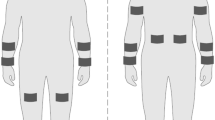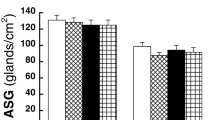Abstract
The purpose of this study was to compare sweating function in sprinters who have trained for several years with untrained subjects and trained endurance runners. Two separate experiments were conducted. Nine sprinters, eight untrained men, and nine distance runners (\(\dot{V}{\text{o}}_{{ 2 {\text{max}}}}\) 50.9 ± 1.4, 38.2 ± 1.8, and 59.1 ± 1.2 mL/kg/min, respectively; P < 0.05) were passively heated for 50 min (Experiment 1), and ten sprinters, 11 untrained men and nine distance runners (similar \(\dot{V}{\text{o}}_{{ 2 {\text{max}}}}\) levels compared with Experiment 1 in each group) had their sweat gland capacity assessed based on acetylcholine-induced sweating rate (SR) (Experiment 2). The slope of the mean non-glabrous SR plotted against change in mean body temperature during passive heating did not differ significantly between sprinters and untrained men (1.21 ± 0.10 and 0.97 ± 0.12 mg cm−2/min/°C, respectively); in contrast, compared with untrained men, distance runners exhibited a significantly greater slope (1.42 ± 0.11 mg cm−2/min/°C, P < 0.05). The mean body temperature threshold for SR was not significantly different among the groups. Acetylcholine-induced SR did not differ significantly between sprinters and untrained men, whereas distance runners showed a significantly higher induced SR compared with untrained men. The sweating function was not improved in sprinters who have trained 2–3 h/day, 5 days/week, for at least 3 years compared with untrained men, although the \(\dot{V}{\text{o}}_{{ 2 {\text{max}}}}\) was markedly greater in sprinters. Thus, there is a case that daily training was not sufficient to improve sweating function in sprinters relative to those in distance runners.




Similar content being viewed by others
References
Amano T, Ichinose M, Koga S, Inoue Y, Nishiyasu T, Kondo N (2011) Sweating responses and the muscle metaboreflex under mildly hyperthermic conditions in sprinters and distance runners. J Appl Physiol 111:524–529
Baum E, Bruck K, Schwennicke HP (1976) Adaptive modifications in the thermoregulatory system of long-distance runners. J Appl Physiol 40:404–410
Berg K, Buresh R, Parks L, Kissinger K, Karasek D, Sinnett A, Trehearn T (2010) Oxygen cost of sprint training. J Sports Med Phys Fit 50:25–31
Buono MJ, Sjoholm NT (1988) Effect of physical training on peripheral sweat production. J Appl Physiol 65:811–814
Buono MJ, McKenzie BK, Kasch FW (1991) Effects of ageing and physical training on the peripheral sweat production of the human eccrine sweat gland. Age Ageing 20:439–441
Buono MJ, Numan TR, Claros RM, Brodine SK, Kolkhorst FW (2009) Is active sweating during heat acclimation required for improvements in peripheral sweat gland function? Am J Physiol Regul Integr Comp Physiol 297:R1082–R1085
Cheuvront SN, Bearden SE, Kenefick RW, Ely BR, Degroot DW, Sawka MN, Montain SJ (2009) A simple and valid method to determine thermoregulatory sweating threshold and sensitivity. J Appl Physiol 107:69–75
Convertino VA (1983) Heart rate and sweat rate responses associated with exercise-induced hypoervolemia. Med Sci Sports Exerc 15:77–82
Convertino VA (1991) Blood volume: its adaptation to endurance training. Med Sci Sports Exerc 23:1338–1348
Cramer MN, Bain AR, Jay O (2012) Local sweating on the forehead, but not forearm, is influenced by aerobic fitness independently of heat balance requirements during exercise. Exp Physiol 97:572–582
Deren TM, Coris EE, Bain AR, Walz SM, Jay O (2012) Sweating is greater in NCAA football linemen independently of heat production. Med Sci Sports Exerc 44:244–252
Gagnon D, Kenny GP (2011) Exercise–rest cycles do not alter local and whole body heat loss responses. Am J Physiol Regul Integr Comp Physiol 300:R958–R968
Gisolfi CV, Cohen JS (1979) Relationships among training, heat acclimation, and heat tolerance in men and women: the controversy revisited. Med Sci Sports 11:56–59
Green JM, Crews TR, Bosak AM, Peveler WW (2003) A comparison of respiratory compensation thresholds of anaerobic competitors, aerobic competitors and untrained subjects. Eur J Appl Physiol 90:608–613
Hardy JD, Hellon RF, Sutherland K (1964) Temperature-sensitive neurons in the dog’s hypothalamus. J Physiol 175:242–253
Henane R, Flandrois R, Charbonnier JP (1977) Increase in sweating sensitivity by endurance conditioning in man. J Appl Physiol 43:822–828
Hessemer V, Zeh A, Bruck K (1986) Effects of passive heat adaptation and moderate sweatless conditioning on responses to cold and heat. Eur J Appl Physiol Occup Physiol 55:281–289
Ichinose-Kuwahara T, Inoue Y, Iseki Y, Hara S, Ogura Y, Kondo N (2010) Sex differences in the effects of physical training on sweat gland responses during a graded exercise. Exp Physiol 95:1026–1032
Irion GL (1987) Responses of distance runners and sprinters to exercise in a hot environment. Aviat Space Environ Med 58:948–953
Jay O, Bain AR, Deren TM, Sacheli M, Cramer MN (2011) Large differences in peak oxygen uptake do not independently alter changes in core temperature and sweating during exercise. Am J Physiol Regul Integr Comp Physiol 301:R832–R841
Kondo N, Nishiyasu T, Inoue Y, Koga S (2010) Non-thermal modification of heat-loss responses during exercise in humans. Eur J Appl Physiol 110:447–458
Linnane DM, Bracken RM, Brooks S, Cox VM, Ball D (2004) Effects of hyperthermia on the metabolic responses to repeated high-intensity exercise. Eur J Appl Physiol 93:159–166
Low PA, Opfer-Gehrking TL, Kihara M (1992) In vivo studies on receptor pharmacology of the human eccrine sweat gland. Clin Auton Res 2:29–34
Maxwell NS, Aitchison TC, Nimmo MA (1996) The effect of climatic heat stress on intermittent supramaximal running performance in humans. Exp Physiol 81:833–845
Nadel ER, Pandolf KB, Roberts MF, Stolwijk JA (1974) Mechanisms of thermal acclimation to exercise and heat. J Appl Physiol 37:515–520
Nakayama T, Eisenman JS, Hardy JD (1961) Single unit activity of anterior hypothalamus during local heating. Science 134:560–561
Okazaki K, Ichinose T, Mitono H, Chen M, Masuki S, Endoh H, Hayase H, Doi T, Nose H (2009) Impact of protein and carbohydrate supplementation on plasma volume expansion and thermoregulatory adaptation by aerobic training in older men. J Appl Physiol 107:725–733
Ooue A, Ichinose-Kuwahara T, Shamsuddin AKM, Inoue Y, Nishiyasu T, Koga S, Kondo N (2007) Changes in blood flow in a conduit artery and superficial vein of the upper arm during passive heating in humans. Eur J Appl Physiol 101:97–103
Palmes ED, Park CR (1947) Thermal regulation during early acclimatization to work in a hot dry environment Fort Knox, KY: US Army Medical Department Field Research Laboratory
Pandolf KB (1979) Effects of physical training and cardiorespiratory physical fitness on exercise–heat tolerance: recent observations. Med Sci Sports 11:60–65
Piwonka RW, Robinson S, Gay VL, Manalis RS (1965) Preacclimatization of men to heat by training. J Appl Physiol 20:379–383
Stapleton J, Gagnon D, Kenny GP (2010) Short-term exercise does not improve whole-body heat loss when rate of metabolic heat production is considered. Eur J Appl Physiol 109:437–446
Stolwijk JA, Hardy JD (1966) Partitional calorimetric studies of responses of man to thermal transients. J Appl Physiol 21:967–977
Wenger CB (1988) Human heat acclimatization. In: Pandolf KB, Sawka MN, Gonzalez RR (eds) Human performance physiology and environmental medicine at terrestrial extremes. Benchmark Press, Indianapolis, pp 153–197
Yamazaki F, Fujii N, Sone R, Ikegami H (1994) Mechanisms of potentiation in sweating induced by long-term physical training. Eur J Appl Physiol Occup Physiol 69:228–232
Yoshida T, Nagashima K, Nose H, Kawabata T, Nakai S, Yorimoto A, Morimoto T (1997) Relationship between aerobic power, blood volume, and thermoregulatory responses to exercise–heat stress. Med Sci Sports Exerc 29:867–873
Zouhal H, Rannou F, Gratas-Delamarche A, Monnier M, Bentue-Ferrer D, Delamarche P (1998) Adrenal medulla responsiveness to the sympathetic nervous activity in sprinters and untrained subjects during a supramaximal exercise. Int J Sports Med 19:172–176
Acknowledgments
We thank our volunteer subjects for participating in this study. This study was partly supported by a Grant-in-Aid for Scientific Research (B) (no. 19300221, 23300231) and a Japan Society for the Promotion of Science (JSPS) Fellowship (no. 244185) from the Ministry of Education, Culture, Sports, Science, and Technology.
Author information
Authors and Affiliations
Corresponding author
Additional information
Communicated by George Havenith.
Rights and permissions
About this article
Cite this article
Amano, T., Koga, S., Inoue, Y. et al. Characteristics of sweating responses and peripheral sweat gland function during passive heating in sprinters. Eur J Appl Physiol 113, 2067–2075 (2013). https://doi.org/10.1007/s00421-013-2641-8
Received:
Accepted:
Published:
Issue Date:
DOI: https://doi.org/10.1007/s00421-013-2641-8




